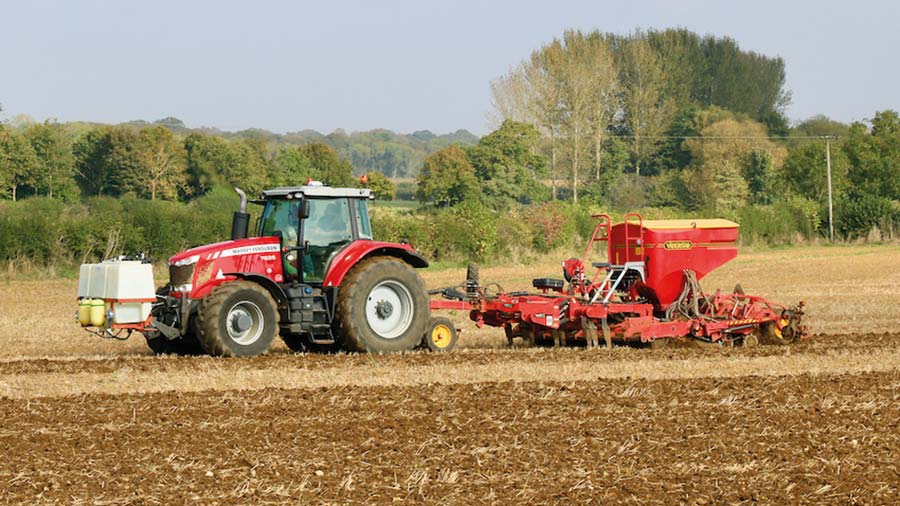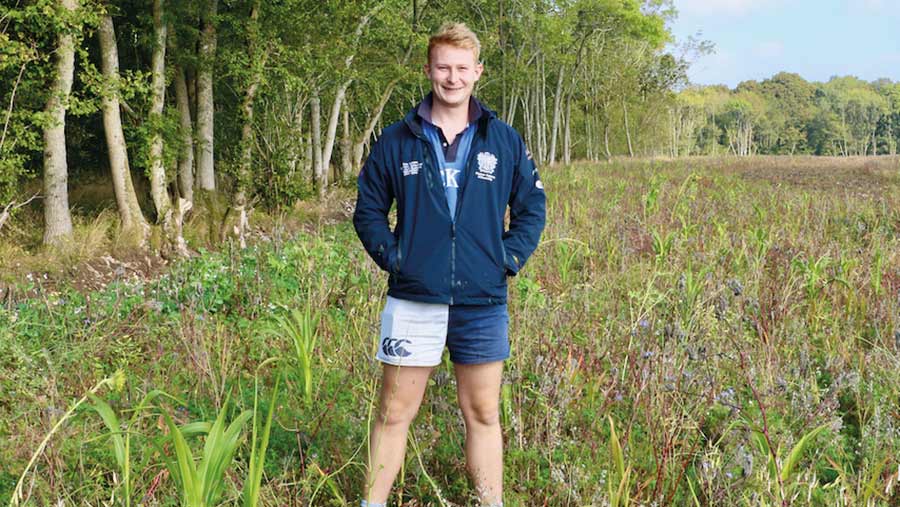Why regen farmer opted for a rotation with no break crops
 © Ben Adams
© Ben Adams A wheat/wheat/fallow rotation might not be in the minds of many growers, especially one committed to moving a business towards a more regenerative approach.
But assuming this season’s trial is a success, that’s the direction an Oxfordshire farm is heading towards.
The rotation that Ben Adams – who farms 400ha of arable crops, plus around 100ha of grassland with his parents, near Bicester – is contemplating isn’t quite as simple as it sounds, however.
See also: Regenerative agriculture: What to avoid and how to start
“The idea has come because there are no break crops worth growing,” he says.
“Spring linseed in 2020 did really well, achieving our second highest gross margin behind winter wheat. But in 2021 it was abysmal.
“So, I want to go back to a wheat/wheat/fallow rotation, but do it better.”
Cover crop
That means a winter wheat crop will be followed with an overwinter cover crop, before spring wheat – chosen rather than spring barley because of its harvest date – followed by a legume-based wholecrop.
If conditions allowed in late October/November, a second winter wheat would be drilled instead of the spring wheat.
The wholecrop – a blend of oats, winter beans, winter vetch and crimson clover – will be harvested by early June before any blackgrass seeds by two beef producers with whom Mr Adams has existing straw for muck deals.
He is hoping the muck can be spread on that land in the drier summer months when there is a lower leaching risk.
Other practices being employed or trialled on the farm
- Home-made compost made from wood chip and farmyard manure
- Johnson-Su bioreactor composting
- Biological inputs
- Intercropping – linseed and oats (oats removed); peas and oats
- Wheat variety blends
- Liquid seed drench applied at drilling
- No conventional seed treatments or insecticides
- No bagged phosphorus and nitrogen in 15-plus years
A summer cover crop will be established after using a low-disturbance subsoiler to rectify any soil damage from harvesting the wholecrop and the muckspreaders before a wheat crop is direct-drilled into the cover.
Finding a consistent way of getting a summer cover crop into the rotation after seeing the amount of insect and biological activity present in them after they were established in fields that had flooded during last winter is another driver for the decision.

© Ben Adams
“The only issue we may face is that under Farming Rules for Water, a summer cover crop doesn’t have any nitrogen requirement, so we might have to grow a maize crop with several companions as maize does have an N [nitrogen] requirement.”
The combination of legume wholecrop, farmyard manure and summer cover crop should reduce the need for applied synthetic nitrogen dramatically in the wheat crop, he believes.
Workload benefits
Another consideration for changing the rotation, notwithstanding the potential benefits in reducing inputs and improvements in soil health, is to improve logistics and spread workload on the farm.
For the past two years, the farm has been overstaffed with Mr Adams returning from travelling post-university and unable to take up employment off the farm because of Covid, adding to three full-time staff, including his father.
But that’s all changed this autumn, with Mr Adams beginning full-time employment with Laurence Gould and another member of staff leaving the farm.
A switch to the new rotation will simplify operations and reduce bottlenecks in operations at key times (see “Operational timeline”).
Operational timeline
- Early-mid August – combine winter wheat
- Late August – drill overwinter cover crop
- Early September – combine spring wheat
- Late September – drill wholecrop legume mix
- October – drill winter wheat
- Spring – drill spring wheat
- Late May – harvest wholecrop mix (by beef farmer neighbours)
- Late June – spread muck
- Early July – drill summer cover crop mix
Financially, he’s aiming to break even with the wholecrop and summer cover crop mix and use the two wheats as cash crops.
“We will need to spread our fixed costs over a smaller area, but the variable costs should decrease as well.
“From a rough budget calculation, the new rotational gross margin £/ha should be about the same as the current rotation. I also want to see how it stacks up financially to the AB15 countryside stewardship option.
“It’s my grand plan but I’m not sure if it will work, which is why we are trialling a field for each of our two beef farmer neighbours to see whether they like the wholecrop and how it works.”
Regen inspiration
A trip organised by the Institute of Agricultural Management to Jake Freestone’s Overbury Farms, while he was a student at Harper Adams University, was the inspiration behind Ben Adams’ desire to change farming philosophy at home.
Understanding the potential cost savings from both direct-drilling and wider input reduction Mr Freestone was achieving was enlightening, he explains.
But the tour round the farm, and through subsequently reading regen books and listening to podcasts, also highlighted the environmental benefits of that approach.
“It changed from a profit-making exercise to also being able to run a sustainable business providing environmental benefits.”
Making money
Profitability remains crucial, he stresses. “As the saying goes, you can’t be green if you’re in the red. But if you can be profitable as well as providing environmental benefits, why wouldn’t you?” he asks.
Since leaving university, Mr Adams has been transitioning the farm with his father towards using regenerative principles more. “Gradually, we’ve become a bit braver.”
Use of cover crops has been extended to before all spring crops in the current winter wheat/spring wheat/winter beans/winter wheat/spring linseed or peas rotation, with the species mix changing from black oats and vetch to a multispecies mix tailored to whether the following crop is a cereal or broadleaf break crop.
Cover crop costs are kept down by using a mixture of roughly £20/ha of bought-in seeds and £5/ha of home-saved seed from oats, linseed and peas, which make up about 50% of the mix.
“You can spend so much money on cover crops so easily, but it needs to make financial sense.
“We made about £13/ha from grazing last year, but livestock can damage the soil if left too long. We want the benefit of the sheep bringing the biomass down, start decomposing and cycling the green matter rather than leaving them on too long for an extra couple of pounds, damaging the top 2in and having to cultivate in the spring.
“If you are going to graze, a good shepherd is paramount.”
Shallower
Tillage depth on the loamy brash/loamy clay soils has been gradually reduced, with a modified Vaderstad Rapid being used to direct-drill where appropriate.
“We’ve sold our plough and Lemken Karat deep tillage cultivator in the past two years and bought a He-Va Stealth low-disturbance subsoiler, which we use if something needs help.”
In the longer term, he hopes to use Defra’s Farming Investment Fund to buy a no-till disc drill.
While it’s early days for assessing the financial benefits of the changes being made, initial calculations suggest input use has reduced by about 30%, partly due to increased spring cropping.
“Our next focus will be on fixed costs. Losing two full-time employees will make a difference and we will eventually go from three tractors to two.
“We’re probably over-capacity with our combine too, especially if we’re reducing the combined area by one-third, so that’s something we’ll need to look at,” he concludes.